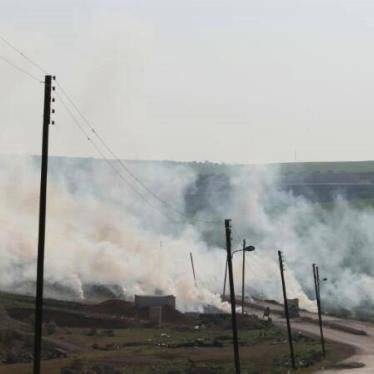Thank you, Mr. Chairperson.
Nearly four decades ago, when a UN disarmament meeting last had an agenda item dedicated to incendiary weapons, the effects of air-dropped napalm and the politics of the era shaped the discussions. The result was Protocol III, which addressed the main problems associated with incendiary weapons in the 1970s, but has proven inadequate to deal with harm they inflict in twenty-first-century conflicts.
Having Protocol III on the agenda this week has rekindled debate about these especially cruel weapons. Almost every state that has spoken on the topic has expressed concern about or condemned the use of incendiary weapons, especially in Syria. A significant number of states have called on the Meeting of High Contracting Parties to continue and deepen discussions next year. Some states have called for strengthening the protocol.
We welcome these interventions but see them as a starting point. We urge the Meeting of High Contracting Parties to set aside more time in 2018 to examine closely the humanitarian harm caused by incendiary weapons and the adequacy of Protocol III. We welcome in particular Switzerland’s proposal to establish an informal meeting of experts on the topic. High contracting parties should have the opportunity to provide further details about their policies and practices, and new states should add their voices to the conversation.
Incendiary weapons produce heat and fire through the chemical reaction of a flammable substance. Due to their extreme heat, they inflict horrific injuries, including fourth- and fifth-degree burns and respiratory damage, and cause long-term and permanent harm. Victims can suffer from psychological trauma and socioeconomic exclusion because they may be socially shunned due to severe scarring and disfigurement.
Protocol III, the only law that specifically deals with incendiary weapons, has two shortcomings that have weakened the norm against the weapons. First, the definition only encompasses weapons that are “primarily designed” to set fires and burn people. It thus excludes weapons that have incendiary effects, including white phosphorus munitions, that may be designed to serve as smokescreens or illuminants, but cause the same horrific effects as other incendiary weapons.
Second, the protocol prohibits the use of air-dropped incendiary weapons in concentrations of civilians, but has less stringent restrictions on the use of ground-delivered models. The weapons cause the same harm to civilians, however, regardless of the delivery mechanism.
These two loopholes would be legally straightforward to close. The definition in Article 1 should be expanded to encompass all weapons with incendiary effects. The restrictions in Article 2 should prohibit the use of all such weapons, regardless of their delivery mechanisms, in concentrations of civilians. In the long run, an absolute ban would have the greatest humanitarian benefits.
In the 1970s, many states called for such a ban on incendiary weapons, yet the 1980 protocol that was ultimately adopted addressed only the major problem of the day—the air attacks on cities and villages with incendiary weapons clearly designed and used to burn and set fires. It was the result of a historical moment and times have changed.
Air-dropped incendiary weapons continue to inflict harm on civilians. This year alone, Human Rights Watch documented 22 incendiary attacks by Syrian government and Russian forces in Syria, and many more have been reported.
In recent years, ground-launched incendiary weapons have also been used, notably in Ukraine. In addition, ground-launched white phosphorus munitions have been used in populated areas in numerous conflict zones, including in Afghanistan, Gaza, Iraq, Syria, and Yemen. In 2017, the US-led coalition used white phosphorus in its fight against ISIS in Raqqa and Mosul.
At the same time, there is growing support for reviewing and strengthening Protocol III. The momentum has built gradually since 2010, and close to 40 states have addressed incendiary weapons in CCW meetings and elsewhere. The time set aside this week represented a notable step forward and high contracting parties should have even more robust discussions next year in order to avoid sliding backward.
High contracting parties frequently refer to the CCW as a dynamic or living instrument that is designed to adapt to changing circumstances. They have revisited other elements of the 1980 treaty, including the framework convention and Protocol II.
It is past time for Protocol III to receive the same attention. In 2018, high contracting parties should commence an overdue review and work to strengthen protections of civilians in light of the current military and political landscape.
For more information, please see the new Human Rights Watch report on incendiary weapons, which was released last week.
Thank you.







